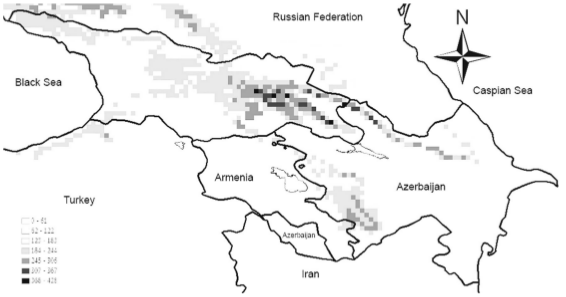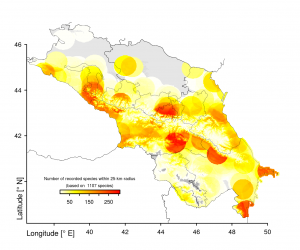Biodiversity is high in the Caucasus Ecoregion. Landscape diversity and species diversity have been the focus of research in the last decades, yielding long species lists in both plant and animal taxa and a high landscape diversity with a very rich mosaic of ecosystems and habitats in this region.
The most species-diverse terrestrial taxon are usually the arthropods, namely insects. Despite a good number of taxonomic and faunistic studies in the Caucasus Ecoregion, we have no precise knowledge on how many arthropod species to expect in this region, even less so concerning species diversity patterns across different habitats, ecosystems, regions or countries. Trends in arthropod diversity in the Caucasus Ecoregion remain unknown.
This situation is true for the spiders too, but it is the only taxon to my knowledge where an up-to-date commented checklist exists and a first attempt at mapping diversity patterns has been unertaken:
Chaladze, G., S. Otto & S. Tramp (2014): A spider diversity model for the Caucasus Ecoregion. Journal of Insect Conservation 18(3): 407-416 DOI 10.1007/s10841-014-9649-1 PDF

Species richness distribution of all species with a valid distribution model across the study area. Darker shades indicate higher predicted numbers of species
Abstract: Precise information on spatial patterns of species richness and endemic species distribution is important for effective species conservation. In the Caucasus Ecoregion such information is virtually non-existent for invertebrate taxa. Using occurrence data from a large database we calculated species distribution models with the GARP algorithm for 471 spider species to visualize the diversity distribution of spider species in this region. Overall species diversity was highest in mountain forests of the North Caucasus, east-central Georgia, the southern slopes of the eastern Great Caucasus and south-east Azerbaijan. A regression tree analysis Chi squared automatic interaction detector method revealed the mean temperature of the driest quarter and precipitation parameters to be the main environmental factors shaping these patterns. Diversity of endemic species was correlated with overall species diversity but hotspots of endemic species (10+ percent of all species) exists in high-mountain areas, suggesting post-glacial speciation events in the high mountains as the main sources of high endemism in Caucasus. Further information on the spatial distribution of species diversity of invertebrate taxa in the Caucasus Ecoregion is needed to improve conservation efforts in this biodiversity hotspot.

Density of spider records in the Caucasus Ecoregion; gray: no records within 25-km-radius; white: 1 record; darkest red: 308 records.
An analysis of the species records in the Caucasian Spiders Database revealed that for most regions in the Caucasus Ecoregion not more than 100 species have been recorded and from some areas not a single spider specimen has ever been collected and published, e.g. the northern parts of Krasnodar Kray, Stavropol Kray, northwestern and western Armenia, regions within and west of Nagorno Karabakh and parts in southern Azerbaijan (see map).
Hotspots of spider species records (red parts) merely reflect the favorite collecting destinations of arachnologists in the past and present, e.g. Tamara Mcheidze collected mostly in and around Tbilisi and Peter Dunin intensively studied the spider fauna of the Apsheron Peninsula around Baku.
![By 池田正樹 (talk) masaki ikeda (Own work) [Public domain], via Wikimedia Commons](http://caucasus-spiders.info/wp-content/uploads/2014/02/263px-Argiope_bruennichi_08Oct10-197x300.jpg)
Argiope bruennichi, (c) Wikimedia Commons
The well-known rapid northward range expansion of this species in the last decades was attributed by the authors to genetic admixture of cold-adaptation alleles from East Asian populations.